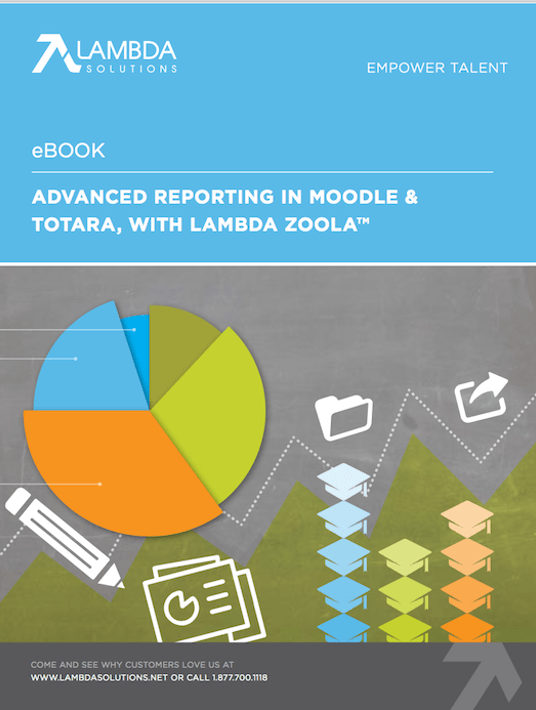Learning Analytics In Instructional Design
Every time a student interacts with your Learning Management System, another piece of data is created and collected. Every login, button click, chat entry, assessment, and time stamp is tracked and recorded. Many Instructional Designers don’t take full advantage of this data—but with learning analytics (LA), you can use that data in powerful ways to impact not only your course design, but much more.

Educators use analytics as a source of feedback, which they can use to tweak their courses [1]. Most instructors leverage LA for activities like the following:
- Monitoring student progress.
- Exploring student data.
- Spotting problems and discovering patterns.
- Finding early indicators for success or failure.
- Assessing the usefulness of learning materials.
- Intervening and helping struggling students.
- Improving their teaching.
But the importance of learning analytics in Instructional Design goes far beyond tactical module improvements. LA provides some enormous benefits to learners, course design, and the organization itself.
In this article, we’ll explore the impact that learning analytics can have on learners, course design, and the broader organization itself.
Impact On Learners
Because learning data captures everything a student does online, it’s possible to create “smart” algorithms that can sense when a student is struggling, based on their behavior. It’s even possible to make early predictions about long-term outcomes. Models that use LA can:
- Identify if a student is disengaged with the course material.
- Predict student achievement.
- Understand how particular students use different learning resources.
Many LMSs can use this learning analytics data to create personalized learning experiences that are customized for each student, based on their behaviors and performance results [2]. Online courses can be personalized in a couple ways:
- Providing options that let learners tailor their learning experience to their preferences. For example, some systems allow students to choose the next topic to work on, or to pick the type of learning activity they like best (video instruction, reading instruction, practice, self-test, etc.).
- Adapting to the learner’s needs based on their performance. This is more common. Typically, it involves assessing the student’s competence or mastery, and providing the appropriate level of learning content—such as prerequisite material or advanced subject matter—depending on the student’s readiness.
For that matter, many systems can even detect when a student is “gaming the system”—taking advantage of the Learning Management System to succeed without putting in the effort to learn. Other models can infer learners’ emotions based on their performance and behavior. The system responds with appropriate tones—supportive for strugglers, sarcastic toward slackers.
Some researchers believe that LA can be used to identify students who are at risk of becoming disengaged, failing, or dropping out of the course. Learning Management Systems can track key indicators, such as forum participation and completed assessments, to calculate a risk score. Widgets such as the Moodle Engagement Analytics Plugin (MEAP) can alert instructors of students that may be headed for failure or dropout. This gives instructors the chance to provide extra help and increase retention.
Impact On Course Design
Learning analytics uses a wide range of data about learners and their behaviors. You can use this data to help design the best learning environment and experience for your students.
There is tremendous potential in the mountains of data that’s collected to better understand how students learn. So far, most of the research has focused on developing models for predicting success and retention. But by analyzing students’ behaviors online, it’s possible to get a better understanding of what environments and experiences are best suited for learning.
There’s a push to discover a generalized model for predicting student success. But some research suggests that the differences between contexts and courses play a major role in effectively predicting whether students will pass or fail [3]. LA can make it possible to understand the contextual variables from course to course, and help Instructional Designers develop learning modules that take those factors into account.
This provides great potential for understanding and optimizing the learning process. By tracking learners’ interactions with the LMS, instructors can pinpoint the most effective techniques and enhance their courses accordingly. (identify the success of their pedagogies).
Gathering more complete data on the student experience can also help your company to spot areas of improvement that students are concerned about—for example, inadequate feedback. These interventions can help instructors build a better course that serves learners’ needs more fully [4].
Impact On The Organization
As improved course designs impact students’ success, you can begin to leverage learning analytics to track the impact on your company’s operational efficiency.
The Kirkpatrick Evaluation Model and the related Phillips’ model were developed to evaluate the effectiveness of online learning based on the impact it has on your organization. But the challenge for many companies is being able to isolate online learning from all the other factors in your company—factors like process improvements, new productivity apps, or culture change.
While it’s impossible to completely isolate the effectiveness of online learning from all other factors in your organization, you can take a broad systems approach and use LA as one of many factors that measure the overall effectiveness of your training and development program [5].
LA can have another, indirect impact on your organization, as well. For some companies, learning analytics has a ripple effect throughout the business. As Instructional Designers increasingly use LA to make better decisions about their course design, other areas of your organization may see the benefits of data-driven decision-making. Before long, they may begin to adopt the practice in their own spheres—increasing the overall efficiency of your company.
Taking Advantage Of Learning Analytics In Instructional Design
Your Learning Management System is automatically tracking and recording all the data you need. The era of big data makes it easy to access anything related to your students’ learning behaviors. Taking advantage of learning analytics gives you a tremendous opportunity to make an impact that goes beyond merely tweaking your online modules. Learning analytics can help you make Instructional Design improvements that affect your learners, the courses themselves, and your organization.
Ready to go deeper in your course design and Learning Management System mastery? Check out our upcoming webinars!
References
- Learning design and learning analytics: building the links
- Using Learning Analytics in Personalized Learning
- Learning analytics should not promote one size fits all: The effects of instructional conditions in predicting academic success
- Learning analytics in higher education
- Learning Analytics that Maximize Business Impact
Related Articles:
- Free eBook: Advanced Reporting In Moodle & Totara, With Zoola Analytics
- 3 Tips To Turn Learning Analytics Into Actionable Outcomes
- 7 Ethical Concerns With Learning Analytics
- What Sources Of Learning Analytics Should You Be Collecting?
- Learning Metrics That Matter: Data Points You Should Be Measuring







